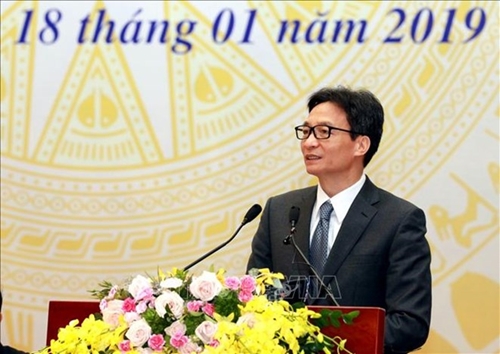“Vietnamese laborers must be well-prepared so that they are able to work in more complex industries and earn higher incomes”, Deputy PM Dam underlined while attending a teleconference to launch tasks of the Ministry of Labor, Invalids and Social Affairs (MoLISA) on January 18.
In particular, training highly skilled workers is an important step as Vietnam moves towards a more open and connected world following on from the Fourth Industrial Revolution, he added.
    |
 |
|
Deputy Prime Minister Vu Duc Dam |
Together with human resources training, Dam noted that the sector should work to fulfil missions in 2019 as entrusted by the National Assembly and Government, including reducing the unemployment rate in urban area to under 4 percent, keeping the percentage of trained laborers at a minimum of 60-62 percent, and cutting the rate of impoverished households by 1-1.5 percent (in line with the multi-dimensional poverty measurement method).
He also hailed the robust achievements attained by the sector in 2018, saying that they made significant contributions to completing the NA and Government’s 12 socio-economic criteria set for the year.
Some 2.21 million people received vocational training in 2018, or 100.5 percent of the estimated figure. Nearly 1.65 million of them went on to obtain jobs within the year, of which over 1.5 million were recruited in domestic firms, and more than 141,000 worked overseas, the highest figure recorded.
Thanks to the sector’s efforts to expand social insurance coverage, some 14.7 million people joined the scheme, accounting for 30.4 percent of the workforce in the country.
It is estimated that 99 percent of the families who had rendered their services to the nation had a higher or equal living standard as compared to the average of their residential areas, all social policy beneficiaries received monthly allowance, 83 percent of people with disabilities received rehabilitation treatment, and 88 percent of children with special circumstances received support.
Regarding the poverty rate, the average figure in the country was 5.35 percent by the end of 2018, 1.35 percent lower than the same period in 2017.
Joining the nation’s efforts to promote administrative reform, the ministry cut 60 out of 107 business conditions, and reduced and simplified 19 out of 31 products that were subject to specialized inspection.
Participants at the event pointed out some limitations of the ministry, including the weak connection between supply and demand, the poor quality of vocational training in some training centers, an unsustainable poverty alleviation program, and public concern over social insurance frauds that caused social anxiety.
Source: VNA